
ドネペジル
概要
説明
Donepezil, commonly known by its brand name Aricept, is a medication primarily used to treat dementia related to Alzheimer’s disease. It is a centrally acting reversible acetylcholinesterase inhibitor, which means it works by increasing the levels of acetylcholine in the brain, a neurotransmitter associated with memory and learning . Donepezil was first approved for medical use in the United States in 1996 and has since become a widely prescribed treatment for Alzheimer’s disease .
作用機序
Target of Action
Donepezil is a selective and reversible acetylcholinesterase inhibitor . Acetylcholinesterase is an enzyme responsible for the breakdown of acetylcholine, a neurotransmitter that plays a crucial role in memory and learning .
Mode of Action
Donepezil interacts with its target, acetylcholinesterase, by reversibly and noncompetitively inhibiting the enzyme .
Biochemical Pathways
The primary biochemical pathway affected by donepezil is the cholinergic pathway . By inhibiting acetylcholinesterase, donepezil increases the concentration of acetylcholine in the brain, enhancing cholinergic activity . This increase in acetylcholine is associated with improvements in memory and learning, which are often deficient in patients with Alzheimer’s disease .
Pharmacokinetics
Donepezil exhibits 100% bioavailability when administered orally . It is metabolized primarily by CYP2D6 and CYP3A4 enzymes and undergoes glucuronidation . The drug has a half-life of around 70 hours , and steady-state concentration is reached in 15-21 days . It is excreted mostly by the kidneys, with around 17% excreted unchanged in the urine .
Result of Action
The increased concentration of acetylcholine in the brain due to donepezil’s action results in enhanced cholinergic activity . This leads to improvements in cognitive function and the ability to perform daily activities, particularly in patients with Alzheimer’s disease .
Action Environment
The action of donepezil can be influenced by various environmental factors. For instance, the presence of other medications can affect the metabolism of donepezil, potentially altering its efficacy and stability . Additionally, patient-specific factors such as age, liver function, and kidney function can also impact the pharmacokinetics and pharmacodynamics of donepezil .
科学的研究の応用
生化学分析
Biochemical Properties
Donepezil is an acetylcholinesterase inhibitor . It increases the levels of a substance (acetylcholine) in the brain involved in memory function by slowing down the breakdown of acetylcholine . This enhances cholinergic transmission, which relieves the symptoms of Alzheimer’s dementia .
Cellular Effects
Donepezil has demonstrated promising effects in cellular and animal models, including promotion of the expression of myelin-related genes and reduction of glial cell reactivity . It may protect neurons via direct and indirect stimulation of nicotinic acetylcholine receptors (nAChRs) against glutamate-induced neurotoxicity .
Molecular Mechanism
Donepezil selectively and reversibly inhibits the acetylcholinesterase enzyme, which normally breaks down acetylcholine . The main pharmacological actions of this drug are believed to occur as the result of this enzyme inhibition .
Temporal Effects in Laboratory Settings
The long-term efficacy and safety of donepezil have been investigated in a 52-week Phase 3 trial . The lifetime expectancies after onset were 7.9 years in the donepezil group and 5.3 years in the non-donepezil group .
Dosage Effects in Animal Models
Donepezil has shown to promote the repair of myelin sheaths in vivo and provides a significant therapeutic effect in a cuprizone-mediated demyelination animal model . It also facilitates the formation of myelin sheaths in OPC–DRG (dorsal root ganglion) neuron co-culture .
Metabolic Pathways
Donepezil is metabolized by first pass metabolism in the liver, primarily by CYP3A4, in addition to CYP2D6 . After this, O-dealkylation, hydroxylation, N-oxidation, hydrolysis, and O-glucuronidation occur, producing various metabolites with similar half-lives to the unchanged parent drug .
Transport and Distribution
Donepezil is largely distributed in the extravascular compartments . It crosses the blood-brain barrier and cerebrospinal fluid concentrations at the above doses have been measured at 15.7% .
Subcellular Localization
Given its mechanism of action, it is likely to be localized in the synaptic cleft where it can inhibit acetylcholinesterase and increase acetylcholine levels .
準備方法
Synthetic Routes and Reaction Conditions: The synthesis of Donepezil typically involves the aldol condensation of benzylpiperidine-carboxyaldehyde with dimethoxyindanone, utilizing the Wittig reaction . This is followed by a dehydration step and catalytic reduction of the exocyclic double bond to yield the desired product .
Industrial Production Methods: Industrial production of Donepezil involves optimizing the synthetic route for large-scale manufacturing. This includes ensuring the efficiency, cost-effectiveness, and scalability of the process. Eco-friendly strategies are also being explored to minimize the environmental impact of the production process .
化学反応の分析
Types of Reactions: Donepezil undergoes various chemical reactions, including oxidation, reduction, and substitution.
Common Reagents and Conditions:
Oxidation: Donepezil can be oxidized using mild oxidants like Chloramine-T in an acidic medium.
Reduction: Catalytic reduction is used in the synthesis process to reduce the exocyclic double bond.
Major Products: The major products formed from these reactions include various Donepezil analogs and derivatives, which are explored for their potential therapeutic benefits .
類似化合物との比較
Rivastigmine: Another acetylcholinesterase inhibitor used to treat Alzheimer’s disease. Unlike Donepezil, Rivastigmine also inhibits butyrylcholinesterase.
Galantamine: This compound not only inhibits acetylcholinesterase but also modulates nicotinic receptors, providing a dual mechanism of action.
Tacrine: An older acetylcholinesterase inhibitor that has largely been replaced by newer drugs like Donepezil due to its side effect profile.
Uniqueness of Donepezil: Donepezil is unique in its high selectivity for acetylcholinesterase and its long half-life, which allows for once-daily dosing . This makes it a convenient option for patients and caregivers, contributing to its widespread use in the management of Alzheimer’s disease .
特性
IUPAC Name |
2-[(1-benzylpiperidin-4-yl)methyl]-5,6-dimethoxy-2,3-dihydroinden-1-one | |
|---|---|---|
| Source | PubChem | |
| URL | https://pubchem.ncbi.nlm.nih.gov | |
| Description | Data deposited in or computed by PubChem | |
InChI |
InChI=1S/C24H29NO3/c1-27-22-14-19-13-20(24(26)21(19)15-23(22)28-2)12-17-8-10-25(11-9-17)16-18-6-4-3-5-7-18/h3-7,14-15,17,20H,8-13,16H2,1-2H3 | |
| Source | PubChem | |
| URL | https://pubchem.ncbi.nlm.nih.gov | |
| Description | Data deposited in or computed by PubChem | |
InChI Key |
ADEBPBSSDYVVLD-UHFFFAOYSA-N | |
| Source | PubChem | |
| URL | https://pubchem.ncbi.nlm.nih.gov | |
| Description | Data deposited in or computed by PubChem | |
Canonical SMILES |
COC1=C(C=C2C(=C1)CC(C2=O)CC3CCN(CC3)CC4=CC=CC=C4)OC | |
| Source | PubChem | |
| URL | https://pubchem.ncbi.nlm.nih.gov | |
| Description | Data deposited in or computed by PubChem | |
Molecular Formula |
C24H29NO3 | |
| Source | PubChem | |
| URL | https://pubchem.ncbi.nlm.nih.gov | |
| Description | Data deposited in or computed by PubChem | |
Related CAS |
120011-70-3 | |
| Record name | Donepezil [INN:BAN] | |
| Source | ChemIDplus | |
| URL | https://pubchem.ncbi.nlm.nih.gov/substance/?source=chemidplus&sourceid=0120014064 | |
| Description | ChemIDplus is a free, web search system that provides access to the structure and nomenclature authority files used for the identification of chemical substances cited in National Library of Medicine (NLM) databases, including the TOXNET system. | |
DSSTOX Substance ID |
DTXSID8048317 | |
| Record name | Donepezil | |
| Source | EPA DSSTox | |
| URL | https://comptox.epa.gov/dashboard/DTXSID8048317 | |
| Description | DSSTox provides a high quality public chemistry resource for supporting improved predictive toxicology. | |
Molecular Weight |
379.5 g/mol | |
| Source | PubChem | |
| URL | https://pubchem.ncbi.nlm.nih.gov | |
| Description | Data deposited in or computed by PubChem | |
Physical Description |
Solid | |
| Record name | Donepezil | |
| Source | Human Metabolome Database (HMDB) | |
| URL | http://www.hmdb.ca/metabolites/HMDB0005041 | |
| Description | The Human Metabolome Database (HMDB) is a freely available electronic database containing detailed information about small molecule metabolites found in the human body. | |
| Explanation | HMDB is offered to the public as a freely available resource. Use and re-distribution of the data, in whole or in part, for commercial purposes requires explicit permission of the authors and explicit acknowledgment of the source material (HMDB) and the original publication (see the HMDB citing page). We ask that users who download significant portions of the database cite the HMDB paper in any resulting publications. | |
Solubility |
31mg/mL | |
| Record name | Donepezil | |
| Source | DrugBank | |
| URL | https://www.drugbank.ca/drugs/DB00843 | |
| Description | The DrugBank database is a unique bioinformatics and cheminformatics resource that combines detailed drug (i.e. chemical, pharmacological and pharmaceutical) data with comprehensive drug target (i.e. sequence, structure, and pathway) information. | |
| Explanation | Creative Common's Attribution-NonCommercial 4.0 International License (http://creativecommons.org/licenses/by-nc/4.0/legalcode) | |
Mechanism of Action |
The commonly accepted cholinergic hypothesis proposes that a portion of the cognitive and behavioral decline associated with Alzheimer's are the result of decreased cholinergic transmission in the central nervous system. Donepezil selectively and reversibly inhibits the acetylcholinesterase enzyme, which normally breaks down acetylcholine. The main pharmacological actions of this drug are believed to occur as the result of this enzyme inhibition, enhancing cholinergic transmission, which relieves the symptoms of Alzheimer's dementia. In addition to the above, other mechanisms of action of donepezil are possible, including the opposition of glutamate-induced excitatory transmission via downregulation of NMDA receptors and the regulation of amyloid proteins, which have demonstrated significant effects on the disease process of Alzheimer's. Other possible targets for donepezil may also include the inhibition various inflammatory signaling pathways, exerting neuroprotective effects., Donepezil hydrochloride, a piperidine derivative, is a centrally active, reversible inhibitor of acetylcholinesterase. The drug is structurally unrelated to other anticholinesterase agents (eg, tacrine, physostigmine)., The precise mechanism(s) of action of donepezil in patients with dementia of the Alzheimer's type (Alzheimer's disease) has not been fully elucidated. The drug is an anticholinesterase agent that binds reversibly with and inactivates cholinesterases (eg, acetylcholinesterase), thus inhibiting hydrolysis of acetylcholine. As a result, the concentration of acetylcholine increases at cholinergic synapses. In vitro data and data in animals indicate that the anticholinesterase activity of donepezil is relatively specific for acetylcholinesterase in the brain compared with butyrylcholinesterase inhibition in peripheral tissues., A deficiency of acetylcholine caused by selective loss of cholinergic neurons in the cerebral cortex, nucleus basalis, and hippocampus is recognized as one of the early pathophysiologic features of Alzheimer's disease associated with memory loss and cognitive deficits. Because the resultant cortical deficiency of this neurotransmitter is believed to account for some of the clinical manifestations of mild to moderate dementia, enhancement of cholinergic function with an anticholinesterase agent, such as tacrine or donepezil, is one of the pharmacologic approaches to treatment. Because widespread degeneration of multiple central neuronal systems eventually occurs in patients with Alzheimer's disease, potentially beneficial effects of anticholinesterase agents theoretically would diminish as the disease process advances and fewer cholinergic neurons remain functioning., Current theories on the pathogenesis of the cognitive signs and symptoms of Alzheimer's Disease attribute some of them to a deficiency of cholinergic neurotransmission. Donepezil hydrochloride is postulated to exert its therapeutic effect by enhancing cholinergic function. This is accomplished by increasing the concentration of acetylcholine through reversible inhibition of its hydrolysis by acetylcholinesterase. There is no evidence that donepezil alters the course of the underlying dementing process., For more Mechanism of Action (Complete) data for Donepezil (6 total), please visit the HSDB record page. | |
| Record name | Donepezil | |
| Source | DrugBank | |
| URL | https://www.drugbank.ca/drugs/DB00843 | |
| Description | The DrugBank database is a unique bioinformatics and cheminformatics resource that combines detailed drug (i.e. chemical, pharmacological and pharmaceutical) data with comprehensive drug target (i.e. sequence, structure, and pathway) information. | |
| Explanation | Creative Common's Attribution-NonCommercial 4.0 International License (http://creativecommons.org/licenses/by-nc/4.0/legalcode) | |
| Record name | Donepezil | |
| Source | Hazardous Substances Data Bank (HSDB) | |
| URL | https://pubchem.ncbi.nlm.nih.gov/source/hsdb/7743 | |
| Description | The Hazardous Substances Data Bank (HSDB) is a toxicology database that focuses on the toxicology of potentially hazardous chemicals. It provides information on human exposure, industrial hygiene, emergency handling procedures, environmental fate, regulatory requirements, nanomaterials, and related areas. The information in HSDB has been assessed by a Scientific Review Panel. | |
CAS No. |
120014-06-4 | |
| Record name | Donepezil | |
| Source | CAS Common Chemistry | |
| URL | https://commonchemistry.cas.org/detail?cas_rn=120014-06-4 | |
| Description | CAS Common Chemistry is an open community resource for accessing chemical information. Nearly 500,000 chemical substances from CAS REGISTRY cover areas of community interest, including common and frequently regulated chemicals, and those relevant to high school and undergraduate chemistry classes. This chemical information, curated by our expert scientists, is provided in alignment with our mission as a division of the American Chemical Society. | |
| Explanation | The data from CAS Common Chemistry is provided under a CC-BY-NC 4.0 license, unless otherwise stated. | |
| Record name | Donepezil [INN:BAN] | |
| Source | ChemIDplus | |
| URL | https://pubchem.ncbi.nlm.nih.gov/substance/?source=chemidplus&sourceid=0120014064 | |
| Description | ChemIDplus is a free, web search system that provides access to the structure and nomenclature authority files used for the identification of chemical substances cited in National Library of Medicine (NLM) databases, including the TOXNET system. | |
| Record name | Donepezil | |
| Source | DrugBank | |
| URL | https://www.drugbank.ca/drugs/DB00843 | |
| Description | The DrugBank database is a unique bioinformatics and cheminformatics resource that combines detailed drug (i.e. chemical, pharmacological and pharmaceutical) data with comprehensive drug target (i.e. sequence, structure, and pathway) information. | |
| Explanation | Creative Common's Attribution-NonCommercial 4.0 International License (http://creativecommons.org/licenses/by-nc/4.0/legalcode) | |
| Record name | Donepezil | |
| Source | EPA DSSTox | |
| URL | https://comptox.epa.gov/dashboard/DTXSID8048317 | |
| Description | DSSTox provides a high quality public chemistry resource for supporting improved predictive toxicology. | |
| Record name | DONEPEZIL | |
| Source | FDA Global Substance Registration System (GSRS) | |
| URL | https://gsrs.ncats.nih.gov/ginas/app/beta/substances/8SSC91326P | |
| Description | The FDA Global Substance Registration System (GSRS) enables the efficient and accurate exchange of information on what substances are in regulated products. Instead of relying on names, which vary across regulatory domains, countries, and regions, the GSRS knowledge base makes it possible for substances to be defined by standardized, scientific descriptions. | |
| Explanation | Unless otherwise noted, the contents of the FDA website (www.fda.gov), both text and graphics, are not copyrighted. They are in the public domain and may be republished, reprinted and otherwise used freely by anyone without the need to obtain permission from FDA. Credit to the U.S. Food and Drug Administration as the source is appreciated but not required. | |
| Record name | Donepezil | |
| Source | Hazardous Substances Data Bank (HSDB) | |
| URL | https://pubchem.ncbi.nlm.nih.gov/source/hsdb/7743 | |
| Description | The Hazardous Substances Data Bank (HSDB) is a toxicology database that focuses on the toxicology of potentially hazardous chemicals. It provides information on human exposure, industrial hygiene, emergency handling procedures, environmental fate, regulatory requirements, nanomaterials, and related areas. The information in HSDB has been assessed by a Scientific Review Panel. | |
| Record name | Donepezil | |
| Source | Human Metabolome Database (HMDB) | |
| URL | http://www.hmdb.ca/metabolites/HMDB0005041 | |
| Description | The Human Metabolome Database (HMDB) is a freely available electronic database containing detailed information about small molecule metabolites found in the human body. | |
| Explanation | HMDB is offered to the public as a freely available resource. Use and re-distribution of the data, in whole or in part, for commercial purposes requires explicit permission of the authors and explicit acknowledgment of the source material (HMDB) and the original publication (see the HMDB citing page). We ask that users who download significant portions of the database cite the HMDB paper in any resulting publications. | |
Melting Point |
223-227 | |
| Record name | Donepezil | |
| Source | DrugBank | |
| URL | https://www.drugbank.ca/drugs/DB00843 | |
| Description | The DrugBank database is a unique bioinformatics and cheminformatics resource that combines detailed drug (i.e. chemical, pharmacological and pharmaceutical) data with comprehensive drug target (i.e. sequence, structure, and pathway) information. | |
| Explanation | Creative Common's Attribution-NonCommercial 4.0 International License (http://creativecommons.org/licenses/by-nc/4.0/legalcode) | |
Synthesis routes and methods I
Procedure details




Synthesis routes and methods II
Procedure details





Synthesis routes and methods III
Procedure details





Synthesis routes and methods IV
Procedure details








Synthesis routes and methods V
Procedure details









Retrosynthesis Analysis
AI-Powered Synthesis Planning: Our tool employs the Template_relevance Pistachio, Template_relevance Bkms_metabolic, Template_relevance Pistachio_ringbreaker, Template_relevance Reaxys, Template_relevance Reaxys_biocatalysis model, leveraging a vast database of chemical reactions to predict feasible synthetic routes.
One-Step Synthesis Focus: Specifically designed for one-step synthesis, it provides concise and direct routes for your target compounds, streamlining the synthesis process.
Accurate Predictions: Utilizing the extensive PISTACHIO, BKMS_METABOLIC, PISTACHIO_RINGBREAKER, REAXYS, REAXYS_BIOCATALYSIS database, our tool offers high-accuracy predictions, reflecting the latest in chemical research and data.
Strategy Settings
| Precursor scoring | Relevance Heuristic |
|---|---|
| Min. plausibility | 0.01 |
| Model | Template_relevance |
| Template Set | Pistachio/Bkms_metabolic/Pistachio_ringbreaker/Reaxys/Reaxys_biocatalysis |
| Top-N result to add to graph | 6 |
Feasible Synthetic Routes
A: Donepezil is a potent and selective inhibitor of acetylcholinesterase (AChE) [, , , ]. AChE is an enzyme that breaks down the neurotransmitter acetylcholine (ACh) in the synaptic cleft. By inhibiting AChE, donepezil increases the concentration of ACh in the synapse, thereby enhancing cholinergic neurotransmission [, ]. This effect is thought to be the primary mechanism by which donepezil exerts its therapeutic effects in Alzheimer's disease (AD), as AD is characterized by a decline in cholinergic function [, , ].
ANone: While this information is readily available in chemical databases and the literature, the current scientific articles provided do not delve into the specific spectroscopic properties of donepezil.
A: Studies have shown that donepezil exhibits stability in various formulations, including oral tablets and transdermal patches [, , ]. Research focusing on the transdermal delivery system (TDS) demonstrates its ability to release donepezil consistently over a period of 72 hours in healthy volunteers []. Notably, the average donepezil residue in the TDS after this period remained high, ranging from approximately 73.9% to 86.7% of the initial loading dose []. This suggests sustained release and stability of donepezil within the TDS matrix.
A: Donepezil acts as an enzyme inhibitor, not a catalyst. It binds to AChE and prevents it from breaking down ACh [, , , ].
ANone: While computational studies are essential in drug discovery, the provided articles do not extensively discuss computational chemistry investigations regarding donepezil.
ANone: While SAR studies are crucial for drug development, the provided articles focus primarily on the clinical effects of donepezil rather than exploring SAR.
A: Donepezil has been formulated for both oral and transdermal delivery, indicating its stability in various pharmaceutical forms [, , ]. Notably, a donepezil transdermal patch has been developed and studied [, , ]. This patch has been shown to deliver donepezil consistently over a 72-hour period, with a high percentage of the drug remaining in the patch after use []. This suggests good stability of donepezil within the patch formulation.
A: Donepezil has shown efficacy in preclinical models and clinical trials for AD [, , , , , , , , , , , ]. In animal models, donepezil has been shown to improve cognitive function and reduce amyloid-beta (Aβ) aggregation, a hallmark of AD [, , ]. Clinical trials have demonstrated that donepezil provides statistically significant, albeit modest, improvements in cognitive function and global function in patients with mild to moderate AD [, , , , , , , , ].
A: While some patients may experience a waning of response to donepezil over time, this is not typically considered to be due to the development of classical drug resistance as seen with antibiotics [, ]. The progressive nature of AD itself is the likely reason for the eventual decline in cognitive function despite treatment [, ].
A: Donepezil is generally well-tolerated, with the most common adverse effects being gastrointestinal in nature, such as nausea, vomiting, and diarrhea [, , , , ]. These side effects are usually mild and transient, often resolving with continued treatment or dose adjustment [, , , , ].
A: The development of the transdermal donepezil patch represents a significant step towards enhancing its delivery profile [, , ]. This delivery route bypasses first-pass metabolism in the liver and potentially offers more consistent drug levels, potentially minimizing side effects [, ].
ANone: While biomarkers for AD diagnosis and progression are constantly being investigated, the use of specific biomarkers to predict or monitor donepezil response remains an active area of research.
A: Research on donepezil employs various analytical techniques, with a particular emphasis on accurately measuring donepezil concentrations in biological samples like plasma [, ]. This is often achieved using highly sensitive and specific methods like liquid chromatography coupled with tandem mass spectrometry (LC-MS/MS) [, ]. This technique enables researchers to quantify even minute amounts of donepezil, which is essential for understanding its pharmacokinetic profile and ensuring appropriate dosage regimens.
ANone: As with many pharmaceuticals, understanding the environmental fate and potential impact of donepezil requires further investigation.
A: Oral donepezil formulations typically exhibit good dissolution and absorption, contributing to its high bioavailability [, ]. The development of transdermal patches aims to further optimize drug delivery and potentially reduce fluctuations in plasma levels [, , ].
A: The use of validated analytical methods is paramount in ensuring accurate and reliable data in donepezil research []. Validation involves rigorous assessments of various parameters including accuracy, precision, specificity, linearity, range, detection limit, quantitation limit, robustness, and system suitability []. By adhering to these stringent standards, researchers can confidently analyze donepezil concentrations in biological samples, facilitating meaningful interpretations of pharmacokinetic and pharmacodynamic data.
A: The production and distribution of donepezil are subject to strict quality control measures throughout the entire process, from development and manufacturing to distribution. These measures ensure the drug's safety, efficacy, and consistency [, ].
A: Donepezil is generally well-tolerated, and significant immune reactions are not commonly reported [, , , , ].
ANone: While donepezil is primarily metabolized by liver enzymes, information regarding specific interactions with drug transporters is limited in the provided research.
A: Donepezil is primarily metabolized by CYP2D6 and CYP3A4 enzymes in the liver [, , ]. Co-administration with drugs that inhibit these enzymes could potentially increase donepezil levels, necessitating dosage adjustments to avoid adverse effects [, , ].
ANone: As with many pharmaceuticals, proper disposal of unused medication and pharmaceutical waste is essential to minimize environmental impact. Specific guidelines may vary depending on local regulations.
A: Research in this field benefits from access to various resources including preclinical models, clinical trial networks, brain imaging facilities, and biological sample repositories [, , , , , , , , ].
A: The approval of donepezil in 1996 marked a significant advancement in the treatment of AD [, , ]. The subsequent development of the transdermal patch formulation further improved treatment options by offering an alternative delivery route with potentially improved adherence and reduced side effects [, , , ].
A: The development and investigation of donepezil exemplify successful cross-disciplinary collaborations, involving researchers from diverse fields such as neuroscience, pharmacology, medicinal chemistry, and clinical medicine []. These collaborations have been instrumental in understanding the mechanism of action, pharmacokinetics, efficacy, and safety of donepezil, ultimately leading to improved treatment options for AD patients [].
試験管内研究製品の免責事項と情報
BenchChemで提示されるすべての記事および製品情報は、情報提供を目的としています。BenchChemで購入可能な製品は、生体外研究のために特別に設計されています。生体外研究は、ラテン語の "in glass" に由来し、生物体の外で行われる実験を指します。これらの製品は医薬品または薬として分類されておらず、FDAから任何の医療状態、病気、または疾患の予防、治療、または治癒のために承認されていません。これらの製品を人間または動物に体内に導入する形態は、法律により厳格に禁止されています。これらのガイドラインに従うことは、研究と実験において法的および倫理的な基準の遵守を確実にするために重要です。
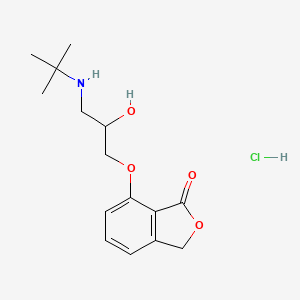
![N-[(3E)-3-benzylidene-9-oxo-1,2-dihydropyrrolo[2,1-b]quinazolin-6-yl]-3-piperidin-1-ylpropanamide](/img/structure/B1670801.png)
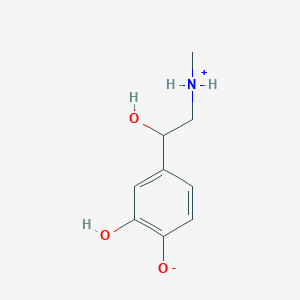
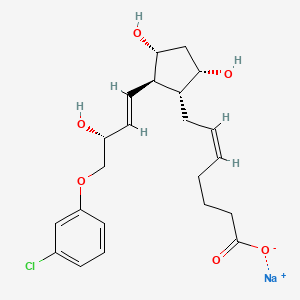
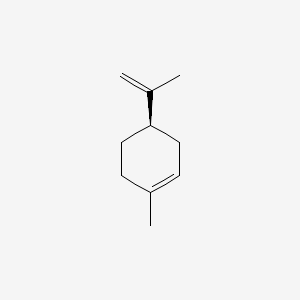
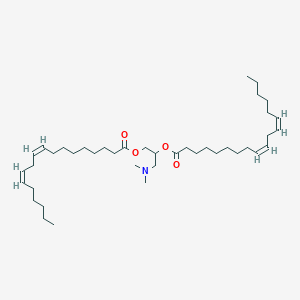
![(2Z,16Z)-22-oxa-5,9,14-triazatetracyclo[16.9.2.01,23.021,28]nonacosa-2,16,18(29),19,21(28)-pentaene-4,15,25-trione](/img/structure/B1670810.png)
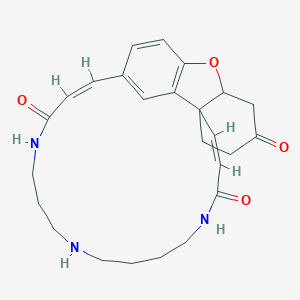

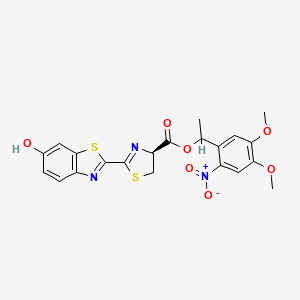
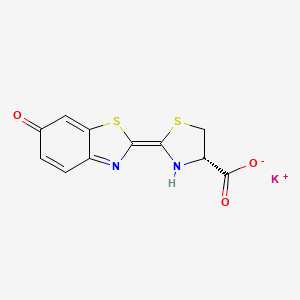

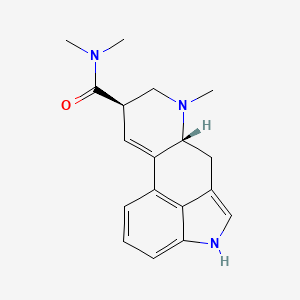
![4-({2-[(4-Tert-butylbenzoyl)amino]benzoyl}amino)benzoic acid](/img/structure/B1670820.png)
